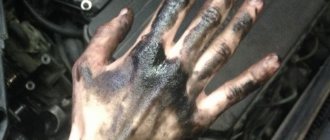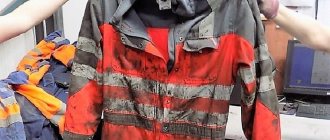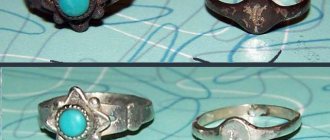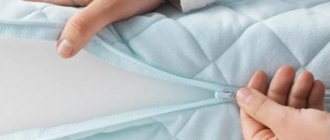Thick fabrics, strong odors, and difficult to remove stains are just some of the problems that a housewife who is forced to wash a work suit may encounter.
According to the rules, washing of workwear must be carried out by the enterprise where the employee works, but not all companies comply with these conditions.
Craftsmen working in private auto repair shops or other similar establishments, in any case, are forced to wash their uniforms with their own hands.
To clean a work suit at home as effectively as possible, you need to know what products are best to use to get rid of difficult stains, how to properly wash and dry the product so that it does not lose its appearance and properties.
How often to wash workwear
There are a number of decrees of the Ministry of Labor regulating the process of providing, cleaning, and replacing workwear at enterprises in various industries.
These documents stipulate that the final schedule for washing work clothes is developed and approved by internal regulations of the enterprise management, according to working conditions and the intensity of pollution.
- In general, regulations recommend washing workwear once every 10 days for moderate soiling, and once every 6 days for heavy soiling.
- For working uniforms of workers in the livestock sector and areas related to sewerage work, it is recommended to clean work clothes once every three days.
- Food workers' clothes are washed daily.
Important! During the procedure, the employee must be provided with a change of clothes.
Who should take care of the care of workwear?
First you need to figure out what exactly belongs to workwear. Now many companies provide employees with corporate uniforms or clothing items: T-shirts, baseball caps, ties, vests, is this also workwear?
If we turn to labor safety standards, then GOST 12.4.280-2014, which regulates the requirements for special clothing, states that it should protect the employee from industrial pollution or mechanical influences. Scope of the standard: industry, housing and communal services, trade, services, hotel services, cleaning services, healthcare. Looking ahead, we can say that legislative and regulatory documents adhere to the same approach. That is, a doctor’s white coat is workwear, but an office worker’s uniform jacket is not.
SanPiN and home washing
According to sanitary rules and regulations, some types of work overalls and trousers are allowed to be washed only in specialized laundries.
This is due to the fact that some types of fabrics are impregnated with special protective solutions that allow the workwear to withstand extremely high or low temperatures.
Home washing of workwear made from such fabrics can deprive them of their protective layer and, as a result, cause injury to an employee whose work clothes have lost their main properties.
Washing in laundries and dry cleaning of workwear made from protective fabric should be carried out with subsequent restoration of the protective layer.
It is also prohibited to wash at home the work clothes of employees whose professional activities involve direct interaction with chemicals or toxic substances.
Such protective clothing must be pre-disinfected.
Attention! It is recommended to pre-ventilate the overalls of employees dealing with fuel and lubricants for several hours.
Service life of workwear
Obviously, when washed or dry cleaned, the fabric loses its properties and becomes thinner. In addition, during use, clothes wear out and tear. How to find a balance between overspending on clothes for employees, their decent appearance and caring for things. What should be the criterion that it is time to buy a new kit?
- The service life of workwear recommended by the manufacturer and indicated on the tag.
- Established standards for providing personnel with special clothing and safety footwear.
- Common sense.
It is clear that management is trying to save money.
Workers have different attitudes towards their work clothes. For one, after a year, the thing is as good as new, and for another, after a couple of weeks you can’t look at it without tears. It is clear that there are unforeseen situations when clothes fail for objective reasons. However, often everything is explained by carelessness and even special neglect of the employer’s property. In order to find a balance and take into account the interests of both parties, norms and regulations have been developed. They will tell the employee how carefully he should treat the things given to him, and they will help the employer calculate the budget and distribute funds. This deadline is also important for accounting – for preparing documents that are submitted to the Tax Inspectorate.
Rules and recommendations for washing, studying the clothing label
In order to effectively and without loss clean a soiled work suit at home, you need to study all the recommendations for caring for the product indicated on the label.
In addition to studying the label data, you need to perform a number of actions:
- determine the composition of the fabric from which the workwear is made;
- find out the maximum permissible temperature of exposure to the product;
- identify the nature of contamination;
- choose the optimal detergent.
Some types of work clothes require special preparation for the cleaning process, so items whose owner regularly comes into contact with gasoline vapors should be ventilated first.
If there is heavy contamination, you can pre-soak the product in water with the addition of washing powder, laundry soap or turpentine.
Tip: in case the label wears out and becomes unreadable, you can rewrite the information on it in advance; if the information on the label is no longer decipherable, you can search for care instructions on the Internet.
Basic Rules
Modern manufacturers of work uniforms guarantee that their products will last at least two years without losing their “marketable appearance.”
But this depends not only on the quality of the material, but also on compliance with a number of recommendations:
- determine the washing method and mode, for which read the symbols on the label (the number indicating degrees indicates the maximum permissible temperature of the aqueous solution);
- determine the composition of the fabric base and select suitable cleaning products;
- take into account the nature of the stains (the time of water procedures and the composition of stain removers depend on this);
- the optimal processing temperature for special fabrics is from 60 to 100 C (high temperatures promote more intensive cleaning, but are not suitable for all fibers).
Ventilate the overalls of workers at gas stations, service stations or oil depots for two hours before soaking. It is advisable to hang the item outdoors.
Read the recommendations on the label
A label can tell you a lot about fabric care if you know what the main signs and letters mean:
- circle - the product can be dry cleaned;
- letter “A” – any solution can be used to remove stains;
- “R” - do not use substances with trichlorethylene;
- “F” – it is allowed to process liquids with petroleum products.
If these recommendations are taken into account, the fibers will retain their shape and strength much longer.
Save the label or write down the information in case it gets worn out or comes off.
Selecting detergents
To maximize the removal of contaminants, it is necessary to choose the right product for home washing of dirty workwear.
The modern chemical industry is ready to present many different products that allow you to remove any stains.
The most gentle way is to soak and wash clothes using ordinary laundry soap, possibly with the addition of soda.
To remove more stubborn stains, you can use active alkalis, such as sodium, but you need to use it very carefully and in small concentrations, otherwise you can damage the fabric structure.
Sodium hydroxide can be used when boiling work clothes, if the care instructions allow it, you need to stir the clothes periodically during the boiling process, otherwise they may not clean evenly or stick to the bottom of the pan.
To get rid of oily, greasy or petroleum stains, you need to use special products developed on the basis of petroleum products; dishwashing detergents can also help.
Note: high-quality workwear should be able to withstand up to 20 washes painlessly.
Using the example of a car mechanic's work clothes
Cotton fabric is well suited for long-term wear. It is light and pleasant to the touch. Before washing, soak it in soapy water and then wash it as usual. If the fabric is heavily soiled, it should be boiled after washing. Add lye to the boiling water. To calculate the amount of lye, weigh the dry clothes. Calculate 1% of this weight, measure out this amount of product and add to the water.
Soda solution copes well with stains. For 1 liter of boiling water you need to add 2 g of the product. It must be added to boiling water. You need to boil things with soda for at least an hour. Stir the clothes from time to time to prevent them from sticking to the bottom of the container.
Rules for soaking
To get rid of the main contaminants, you need to soak the robe for 2-3 hours in warm water with the addition of laundry soap, which needs to be grated.
To enhance the effect, you can add 2-3 tablespoons of soda per 10 liters of water. Some stains may go away after soaking.
If the nature of the dirt is such that simple soaking will not bring results, you can rub the fabric with turpentine or laundry soap and then leave it in water overnight.
After soaking, the product must be rinsed thoroughly and the main washing process can begin either by hand or using a washing machine.
Important! Pre-soaking workwear is a necessity because contaminants such as machine oil, paints, and various solid particles can clog or damage the internal parts of the washing machine.
If you decide to remove dirt with a machine
Most housewives resort to the help of technology. Before you throw your dirty robe into it, read the rules:
- leave clothes with paint or fuel oil residues in hot water for several hours (see section above);
- set the appropriate temperature;
- select normal mode (suitable for most types of coarse fabrics);
- the duration of the procedure depends on the nature and degree of contamination;
- It is advisable to add a stain remover to the powder.
How to deal with fuel oil on special fabrics
Traces of fuel oil are frequent guests on the overalls of workers who service cars at service stations or gas stations. How to remove such stains?
First, remember the means that can remove fuel oil:
- turpentine;
- petrol;
- soda and laundry soap;
- acetone;
- ammonia.
If there are few stains on the form, you can get by with partial soaking. To do this, problem areas are washed with a sponge and one of the indicated products, and then left for one hour.
After this time, it must be rinsed and put into the machine.
Completely soiled clothing should be filled with an aqueous solution, for example, gasoline, rinsed after 3 hours and placed in the washing machine.
Less aggressive ways to get rid of fuel oil:
- Dishwashing detergents. Rub the problem area with the substance and wash after a quarter of an hour.
- Oil (butter or essential oil). Apply a few drops to the stain, and after 20–25 wash it by hand or in a machine.
- Ironing. You need to iron from the wrong side through the paper, then wash.
When everything is washed
After finishing washing, you need to leave the overalls so that the remaining liquid can drain freely. A minimal spin will help maintain the neat appearance of the item.
It is advisable to hang it in the fresh air so that the material dries evenly. Also, air drying will help get rid of or avoid unpleasant odors.
Taking into account the standards for washing workwear, it is possible to thoroughly clean the item, but home cleaning should only be used in cases permitted by sanitary requirements.
Machine washable
Before placing the product in the washing machine, you need to carefully study the washing instructions for individual workwear; it is possible that it only requires hand washing, or machine washing, but at low temperatures or without spinning.
If the manufacturer’s recommendations allow you to machine wash the product, then all conditions must be met; the process will follow the following algorithm:
- studying the manufacturer's recommendations;
- preparing work clothes for washing;
- selection of temperature and spin modes, according to the designations on the label;
- adding washing powder and stain remover.
It doesn’t really matter what kind of washing powder or liquid SMS you use to wash your workwear; a detergent that is used every day when washing other things is quite suitable; it’s better if it contains bioadditives.
Instead of powder, you can use gels intended for cleaning sportswear, since they often contain substances that help dissolve sweat, oils and salts, moreover, they are gentle on fabrics and are completely washed out of the fibers.
Advice: it is better not to use bleaching agents for items made of colored fabrics.
Shelf life of workwear specified by the manufacturer
Manufacturers of workwear, when selecting fabric for their models, are guided by the requirements of GOST 12.4.280-2014 for the following sustainability indicators:
- Surface density.
- Breaking load.
- Abrasion resistance.
In addition, for some categories of clothing the following is taken into account:
- Air tightness.
- Hygroscopicity.
- Oil repellency of a new product even after five washes or dry cleaning.
- Water repellency of a new product even after five washes or dry cleaning.
- Puncture resistance.
- Cut resistance.
Some materials have a limited shelf life in the warehouse, for example, if a rubber coating is applied.
When purchasing, you should definitely pay attention to ensure that workwear and safety footwear are sufficiently “fresh”, otherwise their service life may be significantly reduced due to the loss of the original properties of the fabric. Please answer our questions. This information is important for tracking the quality of workwear:
- How many sets of workwear do you purchase/use per year?
One set lasts more than a year 0 (%) One 0 (%) More than one 0 (%)
To the survey
How many sets of workwear do you purchase/use per year? • One set lasts more than a year • One • More than one
For what reason do work clothes change? • It breaks, loses the necessary properties or acceptable appearance • The deadlines established by the standards pass (1 year)
Wash by hand
If automatic washing is prohibited by the workwear manufacturer, you should do the process manually. Hand washing after pre-soaking in a warm soap and soda solution is to try to scrub off the most stubborn stains.
Heavy stains can be scrubbed with a sponge or brush. After completing the procedure, the fabric must be rinsed thoroughly so that the water ultimately remains clean.
Tip: You can turn over things soaked in caustic solutions using additional tools so that you don’t have to wear gloves every time.
How to deal with fuel oil
Some of the most difficult stains are fuel oil stains, which are most often found on the clothing of workers involved in various types of machinery.
You can wash a car mechanic’s overalls smeared with fuel oil using a number of means:
- turpentine;
- ammonia;
- petrol;
- acetone;
- solvent;
- soda;
- special means
The special product Bioclin-S does a good job of removing oil stains. It was developed for washing oily workwear; it can be used as a stand-alone SMS, or used as an additive to powders for hand and machine washing. The product is available in canisters with a minimum packaging of 5 liters.
It must be used in strict accordance with the attached instructions and in compliance with all safety precautions.
The process of getting rid of fuel oil stains on work clothes is as follows.
- It is necessary to study the care instructions to understand whether aggressive substances can be used for cleaning.
- You should evaluate the scale of contamination; if these are isolated stains, then general soaking of the product is not required, and if the product is more than half dirty, then you should soak it in a gasoline solution for a period of three hours, then rinse thoroughly and wash with detergent.
- Small stains on workwear can be treated with any of the substances listed above. To apply the product, use a sponge, leave the treated stains for an hour, after which the product should be rinsed and washed as usual.
In cases where the use of aggressive compounds can lead to tissue damage, one of the alternative methods should be used:
- Pour dishwashing detergent onto the stain, leave for 10 - 15 minutes, wash as usual;
- Treat the fuel oil stain with butter or essential oil, leave for a few minutes, and wash using standard methods;
- Iron the fabric from the inside out with a hot iron, placing a sheet of paper under the stain; after the procedure, most of the fuel oil will be absorbed into the paper, the remainder will be removed during subsequent washing.
Important: when working with aggressive agents, you must use rubber gloves; you can use a respirator to protect your respiratory tract.
Service life of workwear according to legally established standards
Regulatory documents, first of all, take into account the interests of employees. It is clear that workwear is needed not only to prevent your own from getting dirty. Clothing manufactured in compliance with GOSTs and SanPiNs, first of all, ensures protection of the employee’s health from the hygienic and technical aspects.
However, this does not mean that these documents become burdensome for the employer. On the contrary, often in real conditions the purchase of new workwear is carried out much more often than recommended by the rules. Working conditions make significant adjustments. A work overall torn to shreds or an apron that has lost its protective layer most often proves that the employer chose the right clothes for his employees: it was she, not the people, who suffered!
Order of the Ministry of Labor of Russia No. 997n dated December 9, 2014 approved standard standards according to which the employer must provide employees with special clothing and footwear.
The order contains not only specialties, but also a list of items and their quantity. Table 1. Example of a typical requirement for providing employees with special clothing and safety footwear*.
| Profession | Working clothes and safety footwear | Quantity per year |
| Truck driver | Anti-pollution suit | 1 PC. |
| Polymer coated gloves | 6 pairs | |
| Storekeeper, seller of non-food products | Suit or gown to protect against contamination | 1 PC. |
| Polymer coated gloves | 6 pairs | |
| Janitor, territory cleaner | Suit for protection against pollution and mechanical stress | 1 PC. |
| Apron made of polymer materials with bib | 2 pcs. | |
| Rubber boots with protective toe cap | 1 pair |
*For a complete list, see the Appendix to the order of the Ministry of Labor and Social Protection of the Russian Federation dated December 9, 2014 No. 997n.
The main thing that employees and employers should know is that the employer must take care of the staff, and the employees must treat the issued property with care. The guidelines are the developed GOSTs, SanPiNs, laws, norms and rules.
After washing
When the overalls are washed, you need to leave them in a bathtub or basin for a while so that excess water can drain off.
After this, you need to hang out your work clothes to dry, preferably doing this outdoors. This method will allow the product to dry completely and get rid of any remaining pungent odors.
Washing workwear at home is possible only if it is allowed by SanPiN and does not lead to damage to the product and deprivation of its protective properties, otherwise, it is recommended to entrust the processing of the work suit to professional companies providing dry cleaning services.
Home washing of workwear must be carried out in accordance with the product care instructions and in compliance with all safety measures when working with aggressive substances.
conclusions
- Requirements for organizing the washing of workwear are based on a number of regulatory documents, including those of an industry nature.
- Washing of workwear is organized at the expense of the employer on the territory of the enterprise or performed by a third party.
- The washing process at the enterprise must be regulated by local regulations, and a civil contract is concluded with third-party laundries.
- When choosing a washing method and detergents, it is necessary to take into account the rules for caring for workwear, as well as the type of contamination.
- Proper care of workwear extends its service life and increases the degree of protection for workers.











